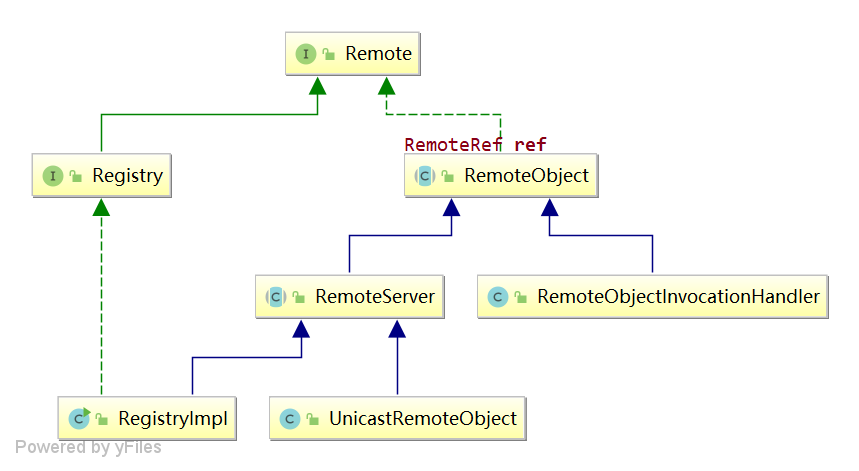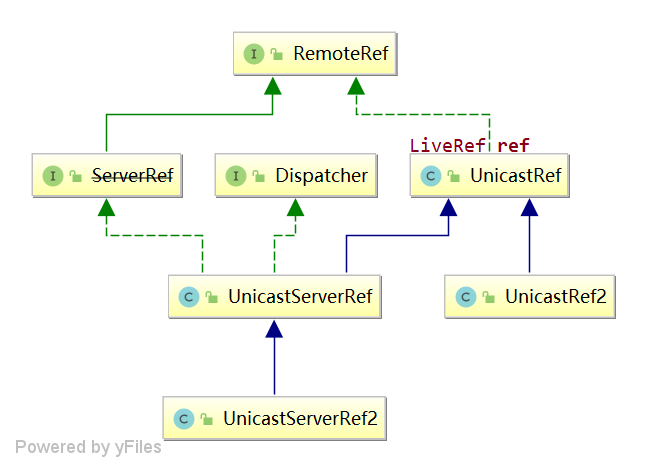RMI 系列(02)源码分析
1. 架构
RMI 中有三个重要的角色:注册中心(Registry)、客户端(Client)、服务端(Server)。
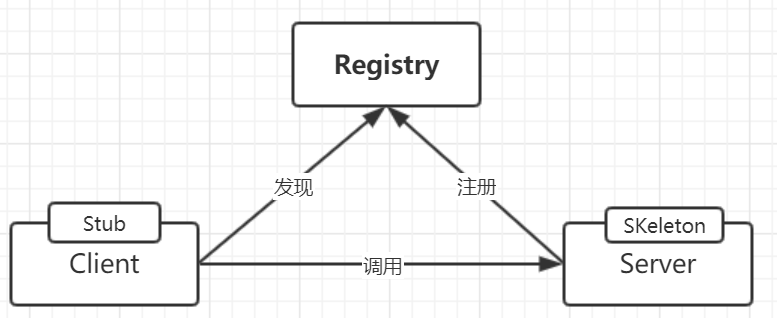
在 RMI 中也要先进行服务注册,客户端从注册中心获取服务。为了屏蔽网络通信的复杂性,RMI 提出了 Stub(客户端存根)和 Skeleton(服务端骨架)两个概念,客户端和服务端的网络信都通过 Stub 和 Skeleton 进行。
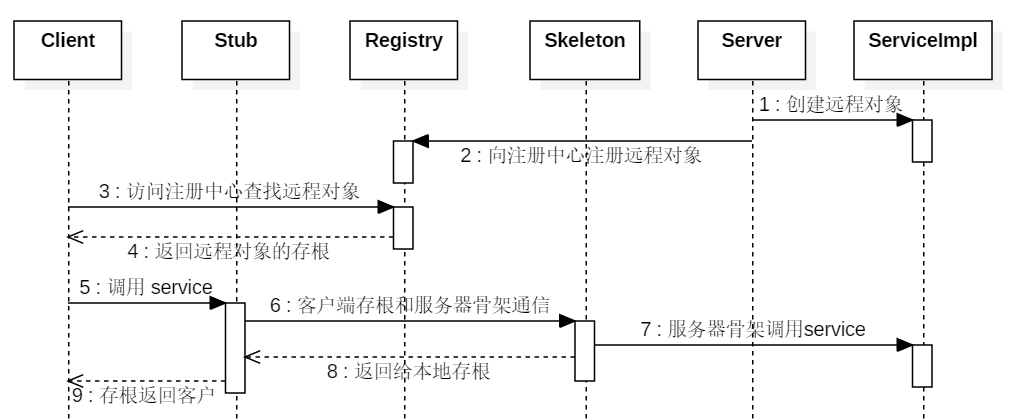
总结: 整体还是可以分为三部分,服务注册、服务发现、服务调用。
- 服务注册(1 ~ 2)
- 第一步:创建远程对象包括两部分。一是创建 ServiceImpl 远程对象;二是发布 ServiceImpl 服务。ServiceImpl 继承自 UnicastRemoteObject,在创建时默认会随机绑定一个端口,监听客户端的请求。所以即使可以不注册,直接请求这个端口也可以进行通信。
- 第二步:向注册中心注册该服务。注意:和其它的注册中心不同,Registry 只能注册本地的服务。
- 服务发现(3 ~ 4)
- 向注册中心查找本地存根,返回给客户端。需要注意的是,Dubbo 先从注册中心获服务的 ip、port 等配置信息,然后在客户端生成 Stub 代理,而 RMI 不一样,已经在服务端保存了 Stub 代理对象,直接通过网络传输直接将 Stub 对象进行序列化与反序列化。
- 服务调用(5 ~ 9)
- 客户端存根和服务器骨架通信,返回结果。
2. 服务注册
首先回顾一下 RMI 服务发布的使用方法:
@Test
public void server() {
// 1. 服务创建及发布。注意:HelloServiceImpl extends UnicastRemoteObject
HelloService service = new HelloServiceImpl();
// 2. 创建注册中心:创建本机 1099 端口上的 RMI 注册表
Registry registry = LocateRegistry.createRegistry(1099);
// 3. 服务注册:将服务绑定到注册表中
registry.bind(name, service);
}
总结: RMI 服务发布有三个流程:
- 服务创建及发布:HelloServiceImpl 需要继承自 UnicastRemoteObject,当初始化时会自动将 HelloServiceImpl 任务一个服务发布,绑定一个随机端口。
- 创建注册中心:注册中心实际和普通的服务一样,也会将自己作为一个服务发布。
- 服务注册:将 service 注册到注册中心。
服务创建及发布和创建注册中心流程完全相同,至于服务注册则是将 service 注册到一个 map 中,非常简单。所以服务的注册主要围绕服务创建及发布展开。
2.1 服务发布整体流程
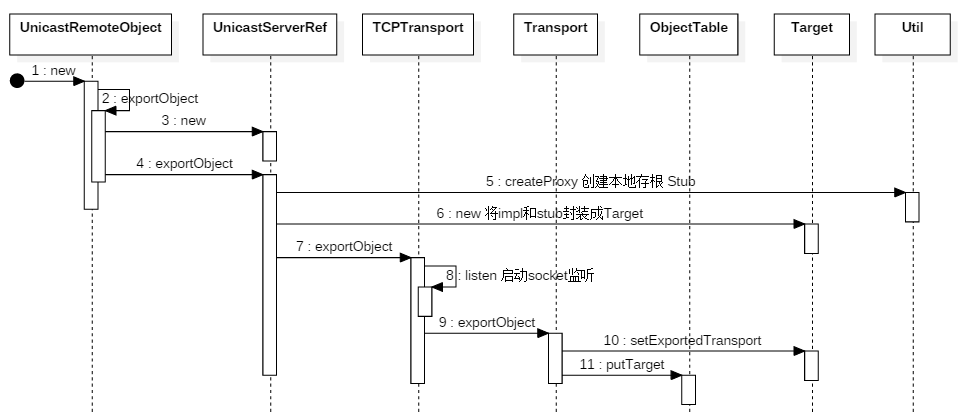
服务的发布的关键点有以下几个:
- 创建本地存根,用于客户端访问。
- 启动 socket。
- 服务注册与查找。
无论是 HelloServiceImpl 还是 Registry 都是 Remote 的子类,准确的说是 RemoteObject 的子类。RemoteObject 最重要的属性是 RemoteRef ref,RemoteRef 的实现类 UnicastRef,UnicastRef 包含属性 LiveRef ref。LiveRef 类中的 Endpoint、Channel 封装了与网络通信相关的方法。类结构如下:
2.2 服务暴露入口 exportObject
HelloServiceImpl 的构造器中调用父类 UnicastRemoteObject,最终调用 exportObject((Remote) this, port)
protected UnicastRemoteObject(int port) throws RemoteException {
this.port = port;
exportObject((Remote) this, port);
}
private static Remote exportObject(Remote obj, UnicastServerRef sref)
throws RemoteException {
if (obj instanceof UnicastRemoteObject) {
((UnicastRemoteObject) obj).ref = sref;
}
return sref.exportObject(obj, null, false);
}
而 Registry createRegistry(int port) 创建注册中心时也会调用 exportObject 方法。
public RegistryImpl(int port) throws RemoteException
LiveRef lref = new LiveRef(id, port);
setup(new UnicastServerRef(lref, RegistryImpl::registryFilter));
}
private void setup(UnicastServerRef uref) throws RemoteException {
ref = uref;
uref.exportObject(this, null, true);
}
总结: Registry 和 HelloServiceImpl 最终都调用 exportObject 方法,那 exportObject 到底是干什么的呢?从字面上看 exportObject 暴露对象,事实上正如其名,exportObject 打开了一个 ServerSocket,监听客户端的请求。
public Remote exportObject(Remote impl, Object data, boolean permanent)
throws RemoteException {
// 1. 创建本地存根,封装网络通信
Class<?> implClass = impl.getClass();
Remote stub = Util.createProxy(implClass, getClientRef(), forceStubUse);
...
// 2. 服务暴露,this 是指 RemoteObject 对象
Target target = new Target(impl, this, stub, ref.getObjID(), permanent);
ref.exportObject(target);
return stub;
}
总结: exportObject 核心的方法有两个:一是生成本地存根的代理对象;二是调用 ref.exportObject(target) 启动 socket 服务。
注意:exportObject 时会先将 impl 和 stub 等信息封装到 Target 对象中,最终注册到 ObjectTable。
2.3 生成本地存根
在 Util.createProxy() 方法中创建代理对象。
public static Remote createProxy(Class<?> implClass, RemoteRef clientRef,
boolean forceStubUse) throws StubNotFoundException {
Class<?> remoteClass = getRemoteClass(implClass);
// 1. 是否存在以 _Stub 结尾的类。remoteClass + "_Stub"
// forceStubUse 表示当不存在时是否抛出异常
if (forceStubUse ||
!(ignoreStubClasses || !stubClassExists(remoteClass))) {
return createStub(remoteClass, clientRef);
}
// 2. jdk 动态代理
final ClassLoader loader = implClass.getClassLoader();
final Class<?>[] interfaces = getRemoteInterfaces(implClass);
final InvocationHandler handler = new RemoteObjectInvocationHandler(clientRef);
return (Remote) Proxy.newProxyInstance(loader, interfaces, handler);
}
总结: 创建代理对象有两种情况:
- 存在以 _Stub 结尾的类(eg: RegistryImpl_Stub)则直接返回,当 forceStubUse=true 时不存在则抛出异常。
- JDK 动态代理。RemoteObjectInvocationHandler#invoke 方法实际上直接委托给了 RemoteRef#invoke 方法进行网络通信,具体代码见
UnicastRef#invoke(Remote, Method, Object[], long)。
2.4 服务监听
跟踪 LiveRef#exportObject 方法,最终调用 TCPTransport#exportObject 方法。
public void exportObject(Target target) throws RemoteException {
// 1. 启动网络监听,默认 port=0,即随机启动一个端口
synchronized (this) {
listen();
exportCount++;
}
// 2. 将 Target 注册到 ObjectTable
super.exportObject(target);
}
总结: 最终服务暴露时做了两件事,一是如果 socket 没有启动,启动 socket 监听;二是将 Target 实例注册到 ObjectTable 对象中。
private void listen() throws RemoteException {
TCPEndpoint ep = getEndpoint();
int port = ep.getPort();
if (server == null) {
server = ep.newServerSocket();
Thread t = new NewThreadAction(new AcceptLoop(server),
"TCP Accept-" + port, true));
t.start();
} catch (IOException e) {
throw new ExportException("Listen failed on port: " + port, e);
}
}
}
2.5 ObjectTable 注册与查找
ObjectTable 用来管理所有发布的服务实例 Target,ObjectTable 提供了根据 ObjectEndpoint 和 Remote 实例两种方式查找 Target 的方法。先看注册:
private static final Map<ObjectEndpoint,Target> objTable = new HashMap<>();
private static final Map<WeakRef,Target> implTable = new HashMap<>();
// Target 注册
static void putTarget(Target target) throws ExportException {
ObjectEndpoint oe = target.getObjectEndpoint();
WeakRef weakImpl = target.getWeakImpl();
synchronized (tableLock) {
if (target.getImpl() != null) {
...
objTable.put(oe, target);
implTable.put(weakImpl, target);
}
}
}
那实例查找也就很简单了,之后就可以根据 Target 对象获取本地存根 stub。
static Target getTarget(ObjectEndpoint oe) {
synchronized (tableLock) {
return objTable.get(oe);
}
}
public static Target getTarget(Remote impl) {
synchronized (tableLock) {
return implTable.get(new WeakRef(impl));
}
}
2.6 服务绑定
当服务 HelloService 和 Registry 均已创建并发布后,之后需要将服务绑定到注册中心。这一步就很简单了,代码 registry.bind(name, service)。
// 服务名称 -> 实例 impl
private Hashtable<String, Remote> bindings = new Hashtable<>(101);
public void bind(String name, Remote obj)
throws RemoteException, AlreadyBoundException, AccessException {
checkAccess("Registry.bind");
synchronized (bindings) {
Remote curr = bindings.get(name);
if (curr != null)
throw new AlreadyBoundException(name);
bindings.put(name, obj);
}
}
总结: service 绑定到注册中心实际就很简单了,将服务名称和实例保存到 map 中即可。查找时可以通过 name 查找到 impl,再通过 impl 在 ObjectTable 中查找到对应的 Target。
2.7 总结
服务暴露主要完成两件事:一是服务端生成本地存根 stub,并包装成 Target 对象,最终注册到 ObjectTable 中;二是启动 ServerSocket 绑定端口,监听客户端的请求。 又可以分为普通服务暴露和注册中心暴露,两种服务暴露过程完全相同。
- 普通服务暴露(HelloService):默认绑定随机端口。使用 HelloServicempl 实例,根据动态代理生成本地存储 stub,RemoteObjectInvocationHandler#invoke 最终调用
UnicastRef#invoke(Remote, Method, Object[], long)方法。 - 注册中心暴露(Registry):LocateRegistry.createRegistry(port) 需要指定绑定端口,默认 1099。使用 RegistryImpl 实例,本地存根使用 RegistryImpl_Stub。
3. 服务发现
@Test
public void client() {
String name = HelloService.class.getName();
// 获取注册表
Registry registry = LocateRegistry.getRegistry("localhost", 1099);
// 查找对应的服务
HelloService service = (HelloService) registry.lookup(name);
}
总结: RMI 服务发现核心步骤两步:一是获取注册中心 registry;二是根据注册中心获取服务的代理类 service。registry 和 service 都是通过 Util.createProxy() 方法生成的代理类,不过这两个代理类的生成时机完全不同,registry 是在客户端生成的代理类,service 是在服务端生成的代理类。
3.1 注册中心 Stub
public static Registry getRegistry(String host, int port, RMIClientSocketFactory csf) {
LiveRef liveRef = new LiveRef(new ObjID(ObjID.REGISTRY_ID),
new TCPEndpoint(host, port, csf, null), false);
RemoteRef ref = (csf == null) ? new UnicastRef(liveRef) : new UnicastRef2(liveRef);
return (Registry) Util.createProxy(RegistryImpl.class, ref, false);
}
由于默认存在 RegistryImpl_Stub,所以直接返回 RegistryImpl_Stub 的实例。
public Remote lookup(String var1) throws AccessException, NotBoundException, RemoteException {
RemoteCall var2 = super.ref.newCall(this, operations, 2, 4905912898345647071L);
ObjectOutput var3 = var2.getOutputStream();
var3.writeObject(var1);
super.ref.invoke(var2);
ObjectInput var6 = var2.getInputStream();
Remote var23 = (Remote)var6.readObject();
super.ref.done(var2);
return var23;
}
总结: LocateRegistry.getRegistry 获取注册中心时,在客户端直接生成代理对象 RegistryImpl_Stub,RegistryImpl_Stub 实际调用 RemoteRef 的 invoke 方法进行网络通信。
3.2 普通服务 Stub
和 RegistryImpl_Stub 不同,普通服务是在服务端生成本地存根 Stub。在服务注册的阶段,我们提到服务暴露时会将服务实例及其生成的 Stub 包装成 Target,并最终注册到 ObjectTable 上。那客户端 registry.lookup(name) 是如何最终查找到对应服务的 Stub 中的呢?
首先客户端调用 registry.lookup(name) 时,会通过网络通信最终调用到 RegistryImpl#lookup 方法,查找到对应的 Remote 实例,之后将这个实例返回给客户端。
但是这个 Socket 输出流是被 MarshalOutputStream 包装过的,在输出对应时会将 Remote 替换为 Stub 对象。也就是说客户端直接可以拿到代理后的对象,反序列后进行网络通信,不需要在客户端生成代理对象。代码如下:
protected final Object replaceObject(Object obj) throws IOException {
if ((obj instanceof Remote) && !(obj instanceof RemoteStub)) {
Target target = ObjectTable.getTarget((Remote) obj);
if (target != null) {
return target.getStub();
}
}
return obj;
}
总结: registry.lookup(name) 获取服务端生成的代理对象 stub。这个 stub 代理对象调用 UnicastRef#invoke(Remote, Method, Object[], long) 方法进行网络通信。
注意: 如果该服务没有暴露,则 target=null,也就是直接将服务端注册的实例而不是存根 Stub 返回,所以在客户端必须有该类的实现,否则反序列反时会抛出异常。不过,不暴露服务这种情况好像并没有什么意义。
Exception in thread "main" java.rmi.UnmarshalException: error unmarshalling return; nested exception is:
java.lang.ClassNotFoundException: com.binarylei.rmi.helloword.service.HelloServiceImpl (no security manager: RMI class loader disabled)
at sun.rmi.registry.RegistryImpl_Stub.lookup(Unknown Source)
at com.binarylei.rmi.helloword.ClientTest.main(ClientTest.java:21)
Caused by: java.lang.ClassNotFoundException: com.binarylei.rmi.helloword.service.HelloServiceImpl (no security manager: RMI class loader disabled)
at sun.rmi.server.LoaderHandler.loadClass(LoaderHandler.java:396)
at sun.rmi.server.LoaderHandler.loadClass(LoaderHandler.java:186)
at java.rmi.server.RMIClassLoader$2.loadClass(RMIClassLoader.java:637)
at java.rmi.server.RMIClassLoader.loadClass(RMIClassLoader.java:264)
at sun.rmi.server.MarshalInputStream.resolveClass(MarshalInputStream.java:219)
... 2 more
4. 服务调用
RMI 中网络通信相关的逻辑都是由 RemoteRef 完成的,客户端的实现是 UnicastRef,而服务端则是 UnicastServerRef。
4.1 客户端调用过程

客户端生成的代理对象调用 UnicastRef.invoke 进行网络传输,至少要告诉服务端以下信息:
- 接口名
- 方法名称
- 参数类型
- 参数
通过 接口 + 方法名称 + 参数类型 三个坐标就可以确定调用的具体方法。RMI 中通过传递 opnum 参数标记是这个类的第几个方法来确定。
public Object invoke(Remote obj, Method method, Object[] params, long opnum)
throws Exception {
// 1. create call context
Connection conn = ref.getChannel().newConnection();
RemoteCall call = new StreamRemoteCall(conn, ref.getObjID(), -1, opnum);
// 2. marshal parameters
try {
ObjectOutput out = call.getOutputStream();
marshalCustomCallData(out);
Class<?>[] types = method.getParameterTypes();
for (int i = 0; i < types.length; i++) {
marshalValue(types[i], params[i], out);
}
} catch (IOException e) {
throw new MarshalException("error marshalling arguments", e);
}
// 3. unmarshal return
call.executeCall();
try {
Class<?> rtype = method.getReturnType();
if (rtype == void.class)
return null;
ObjectInput in = call.getInputStream();
Object returnValue = unmarshalValue(rtype, in);
ref.getChannel().free(conn, true);
return returnValue;
} finally {
// 关闭连接等
call.done();
}
}
总结: UnicastRef.invoke 方法过程很清晰,先发送 opnum,再发送参数,最后处理返回结果。
4.2 服务端处理过程
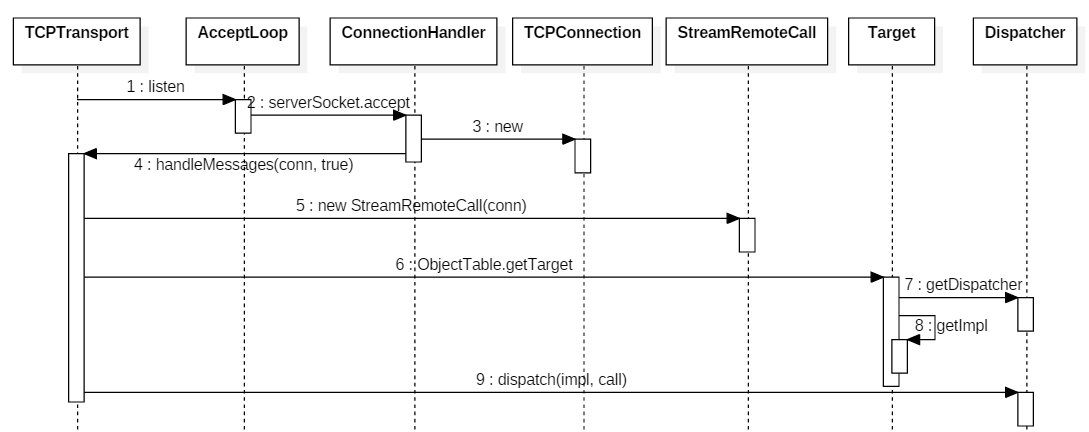
总结:
-
服务暴露时,通过 listen 方法启动 socket,创建 AcceptLoop 线程接收客户端的连接,每一个 socket 连接创建一个 ConnectionHandler 处理,这也是 BIO 处理客户端连接的基本套路。
-
然后从 ObjectTarget.getTarget 中获取服务端保存的 Target 对象,可以获取 impl 和 dispatcher 对象。dispatcher 的实现类是 UnicastServerRef。
-
服务端获取 opnum 确定具体的方法 method,再接收方法的参数,调用 method.invoke(obj, params) 后将结果返回给客户端。
下面就看一下 UnicastServerRef#dispatch 具体做了些什么。
public void dispatch(Remote obj, RemoteCall call) throws IOException {
// positive operation number in 1.1 stubs;
// negative version number in 1.2 stubs and beyond...
int num;
long op;
// 1. 处理 num 和 op 参数,jdk1.1 oldDispatch
try {
ObjectInput in;
try {
in = call.getInputStream();
num = in.readInt();
if (num >= 0) {
if (skel != null) {
oldDispatch(obj, call, num);
return;
} else {
throw new UnmarshalException(
"skeleton class not found but required for client version");
}
}
op = in.readLong();
} catch (Exception readEx) {
throw new UnmarshalException("error unmarshalling call header", readEx);
}
MarshalInputStream marshalStream = (MarshalInputStream) in;
marshalStream.skipDefaultResolveClass();
// 2. 根据 op 获取 method
Method method = hashToMethod_Map.get(op);
// 3. unmarshal parameters
Object[] params = null;
try {
unmarshalCustomCallData(in);
params = unmarshalParameters(obj, method, marshalStream);
} finally {
call.releaseInputStream();
}
// 4. make upcall on remote object
Object result;
try {
result = method.invoke(obj, params);
} catch (InvocationTargetException e) {
throw e.getTargetException();
}
// 5. marshal return value
try {
ObjectOutput out = call.getResultStream(true);
Class<?> rtype = method.getReturnType();
if (rtype != void.class) {
marshalValue(rtype, result, out);
}
} catch (IOException ex) {
throw new MarshalException("error marshalling return", ex);
}
} catch (Throwable e) {
ObjectOutput out = call.getResultStream(false);
out.writeObject(e);
} finally {
call.releaseInputStream(); // in case skeleton doesn't
call.releaseOutputStream();
}
}
总结: UnicastServerRef#dispatch 方法也很清晰,无非是根据 op 确定具体的方法 method,获取参数,将反射的结果通过网络返回给客户端。
每天用心记录一点点。内容也许不重要,但习惯很重要!
